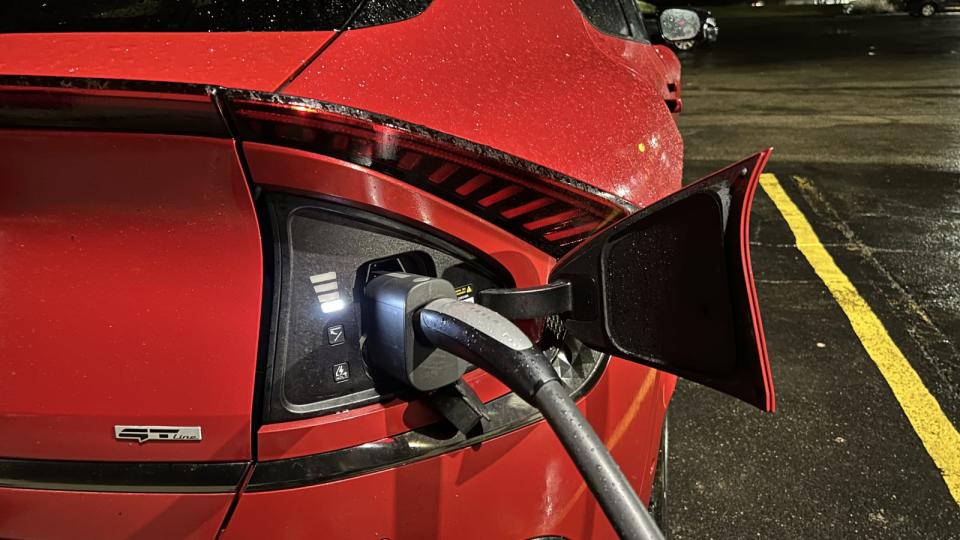We charged a non-Tesla at a Supercharger. Here's how it went

FREDONIA, N.Y. — Tesla opened up a small part of its Supercharger network to non-Tesla vehicles a couple of weeks ago, and as soon as the news hit, we downloaded the Tesla app and tried to find a compatible charger near our editors in Detroit and Los Angeles. First mistake! There were no Superchargers open to non-Teslas in the greater Los Angeles area nor the entire state of Michigan at the time of this article’s publishing. The closest compatible charger was in … Fredonia, N.Y.
That’s approximately a five-hour drive from home, so we put in motion plans to get there and try it out. The steed? Our long-term 2022 Kia EV6 GT-Line. It’s already proven to be a spectacular electric road trip companion, offering up fast charge speeds and a respectable range between charges.
The prep work to charge a non-Tesla at a Supercharger is similar to that of many electric charging apps like Electrify America or EVGo. Download the app, make an account and enter in a credit card. Tesla makes getting going easy with clear prompts in the app, and it’s a seriously slick and fast app at that.

Arriving at a compatible Tesla Supercharger location is when things are likely to go sideways. The first problem is simple parking logistics. Tesla designed its chargers to work with the charge port location of Tesla vehicles, which is on the driver-side rear quarter panel adjacent to the taillights. The cords were only ever made long enough for a Tesla to back into a spot and safely reach this location. By our estimation, you’re likely to struggle unless your non-Tesla EV shares the Tesla’s charge point location (Polestar 2 and Hummer EV), is located at the very front of the car (Kia Niro EV, Hyundai Kona EV) or maybe the front passenger side (Porsche Taycan and Audi E-Tron GT). That’s not many cars; most other EVs have a different location.
For example, the Ford F-150 Lightning and Mustang Mach-E, Cadillac Lyriq, Rivian R1S and R1T, and Lucid Air all have theirs on the driver side, but at the front – the cord definitely won’t reach if you back them in, and there’s a good chance you’ll bump into the charger’s concrete bollards should you try to inch close enough going forward.




Our EV6 has the other common location, on the passenger-side rear, which presents a slightly different issue. Parked side-by-side with another Tesla, the two of you will end up fighting for the same plug. Practically speaking, us being plugged in on the “wrong side” with our EV6 makes one of the charging spaces useless for a Tesla owner who may come along. Unless there are lots of open spots, this sure seems inconsiderate, and we don’t encourage it. Queue the angry social media posts in 3, 2, 1 …
Once you get the logistics of the situation sorted, beginning a charge session is simple and done 100% through the app. Just pull up the Supercharger station you’re at within the Tesla app, tap on the specific charger you’re going to plug into (they’re clearly labeled by number and letter), and then tap the big blue button that says “unlock adapter.” This unlocks the “Magic Dock” that Tesla has installed at these charger stations. The Magic Dock is necessary because it contains the adapter from Tesla’s J1772 connector to the CCS (Combined Charging System) connector used by the EV6 and most other EVs — this is why only certain locations are available now, because Tesla needs to install Magic Docks everywhere it intends to allow non-Teslas to charge. It only takes a second after hitting this button for the adapter to unlock, and once it’s done so, you go grab the connector, push in, and the charger with the CCS adapter falls out. After that, it’s as easy as plugging in your car. Tesla says that it could take as much as two minutes for charging to begin, but it only took about 5-10 seconds in our experience.

 Yahoo Autos
Yahoo Autos 
